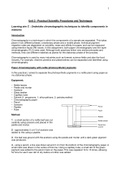1
Unit 2 - Practical Scientific Procedures and Techniques
Learning aim C : Undertake chromatographic techniques to identify components in
mixtures
Introduction
Chromatography is a technique in which the components of a sample are separated. This takes
place in two di erent phases: a stationary phase and a mobile phase. Individual pigment
migration rates are dependent on solubility, mass and a nity for paper, and can be measured
using retention factor (Rf) values. In this assignment, both paper chromatography and thin layer
chromatography (TLC) were used. Although both practices follow very similar principles and
methods, they use di erent materials as planes for the stationary phase of the process.
Chromatography is used by many industries such as forensic science elds and also the food
industry. For example, vitamins proteins and preservatives can be separated and identi ed using
chromatography.
Paper chromatography with nettle (photosynthetic) pigments
In this practical, I aimed to separate the photosynthetic pigments in a nettle plant using paper as
my stationary phase.
Equipment:
- Nettle leaves
- Pestle and mortar
- Acetone
- Glass beaker
- Capillary tube
- Solvent (1: propanone, 1: ethoxyethane, 2: petroleumether)
- Chromatography paper
- Pencil
- Scissors
- Pipette Pencil
- Ruler Paper
Method:
Beaker
1 - a small section of a nettle leaf was cut Nettle extract
carefully using scissors and placed in the
pestle and mortar. Pencil line
solvent
2 - approximately 5 cm^3 of acetone was
added to this using a pipette.
3 - the leaf was ground with the acetone using the pestle and mortar until a dark green pigment
was produced.
4 - using a pencil, a line was drawn around 2 cm from the bottom of the chromatography paper. A
small mark was drawn in the centre of this line. Using a capillary tube, a small dot of the green
pigment was added to the pencil mark on the paper. This was repeated 10 to 15 times, allowing
for time for each new dot to dry before a further was added.
ff ff ffi fi fi
, 2
5 - approximately 10 cm^3 of the solvent was added to the beaker.
Once dried, the chromatography paper with the pigment was stood
carefully in the beaker, ensuring the pencil line was above the solvent
line. A pencil was used to hold this in place.
6 - the paper was taken out of the solvent around 30 minutes later,
once the solvent line had travelled close to the top of the paper. By
this point, various pigments were visible. A pencil was used to make Solvent line
D
C
the solvent line.
B
A
7 - once allowed to dry for a few minutes, a pencil was used to mark
the top of each pigment. It is important this is done soon after the
experiment as the pigments will fade over time.
8 - using the pencil markings of the pigments and solvent line, Rf Pencil line
values could be calculated.
Results are as shown
Thin-layer chromatography (TLC) with ne le (photosynthe c) pigments
In this practical, I aimed to separate the photosynthetic pigments in a
nettle plant using a TLC plate (silica coated) as my stationary phase. I
Equipment:
H
- Nettle leaves G
- Pestle and mortar F
- Acetone E
D
- Glass chamber tube C
- bung
- Capillary tube B
- Solvent (1: propanone, 1: ethoxyethane, 2: petroleumether) A
- TLC plate
- Pencil
- Scissors
- Pipette
- Ruler
Method :
The equipment was set up in the same manner as shown above, the only di erence being a bung
was used to hold the plate in place, and a smaller glass tube was used to contain it.
1 - a small section of a nettle leaf was cut carefully using scissors and placed in the pestle and
mortar.
2 - approximately 5 cm^3 of acetone was added to this using a pipette.
3 - the leaf was ground with the acetone using the pestle and mortar until a dark green pigment
was produced.
4 - using a pencil, a line was drawn around 2 cm from the bottom of the TLC plate, on the matte
side. A small mark was drawn in the centre of this line. Using a capillary tube, a small dot of the
green pigment was added to the pencil mark on the paper. This was repeated 10 to 15 times,
allowing for time for each new dot to dry before a further was added.
tt ti ff




